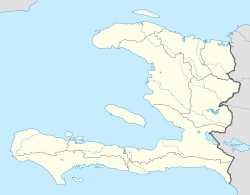La Navidad
| La Navidad | |
|---|---|
| Location in present day Haiti | |
| Coordinates: 19°41′26″N 72°00′57″W / 19.69056°N 72.01583°WCoordinates: 19°41′26″N 72°00′57″W / 19.69056°N 72.01583°W |
La Navidad was a settlement that Christopher Columbus and his men established in present-day Haiti in 1492 from the remains of the Spanish ship, the Santa María. La Navidad was the first European colony established in the New World during the Age of Discovery, though it was destroyed the following year.
Columbus sailed around the island of Hispaniola on Christmas Eve of 1492, during his first voyage. One of his ships, the Santa María, drifted onto a bank and heeled over. After hearing from Guacanagari that there was much gold to be had on the island, Columbus decided that he would leave the crew of his wrecked vessel to make a settlement on the island and gather the promised gold. To this end he ordered the ship dismantled to provide the building materials for a small fortress.
"I have ordered a tower and fortress to be constructed and, a large cellar, not because I believe there is any necessity on account of [the natives]," he noted in his journal. "I am certain the people I have with me could subjugate all this island … as the population are naked and without arms and very cowardly."
Columbus called the port Puerto de la Navidad ("Christmas Port"), the day he landed there. He appointed Diego de Arana, chief constable of the fleet and son of Rodrigo, Pedro Gutiérrez, butler of the Spanish royal dais, and Rodrigo de Escobedo to govern the fortress of 36 men. These included carpenters, calkers, a physician, a tailor, and a gunner. Additionally, the settlement was supplied with provisions, trading goods, arms and artillery.
On Friday, January 4, 1493, Columbus set sail in the Niña in search of the third ship in the fleet, the Pinta. The Pinta was commanded by Martín Alonzo Pinzón, and had been absent for six weeks. On the night of November 21, the caravel Pinta had vanished into the darkness off the coast of Cuba, and in his journal Columbus accused Pinzón of deliberately having separated the Pinta from the other ships in order to beat the admiral to the rich sources of gold which Columbus imagined were in the immediate area. Even more disquieting was his fear that Pinzón might break for Spain in the fast-sailing Pinta to be the first to bring news of the discovery to the Catholic Monarchs and to "tell them lies" about the admiral's conduct of the expedition. On Sunday morning, January 6, 1493, the missing Pinta was spotted approaching from the east, and after a heated argument between the two men, the fleet returned to gather people and supplies for a return voyage.
...
Wikipedia

